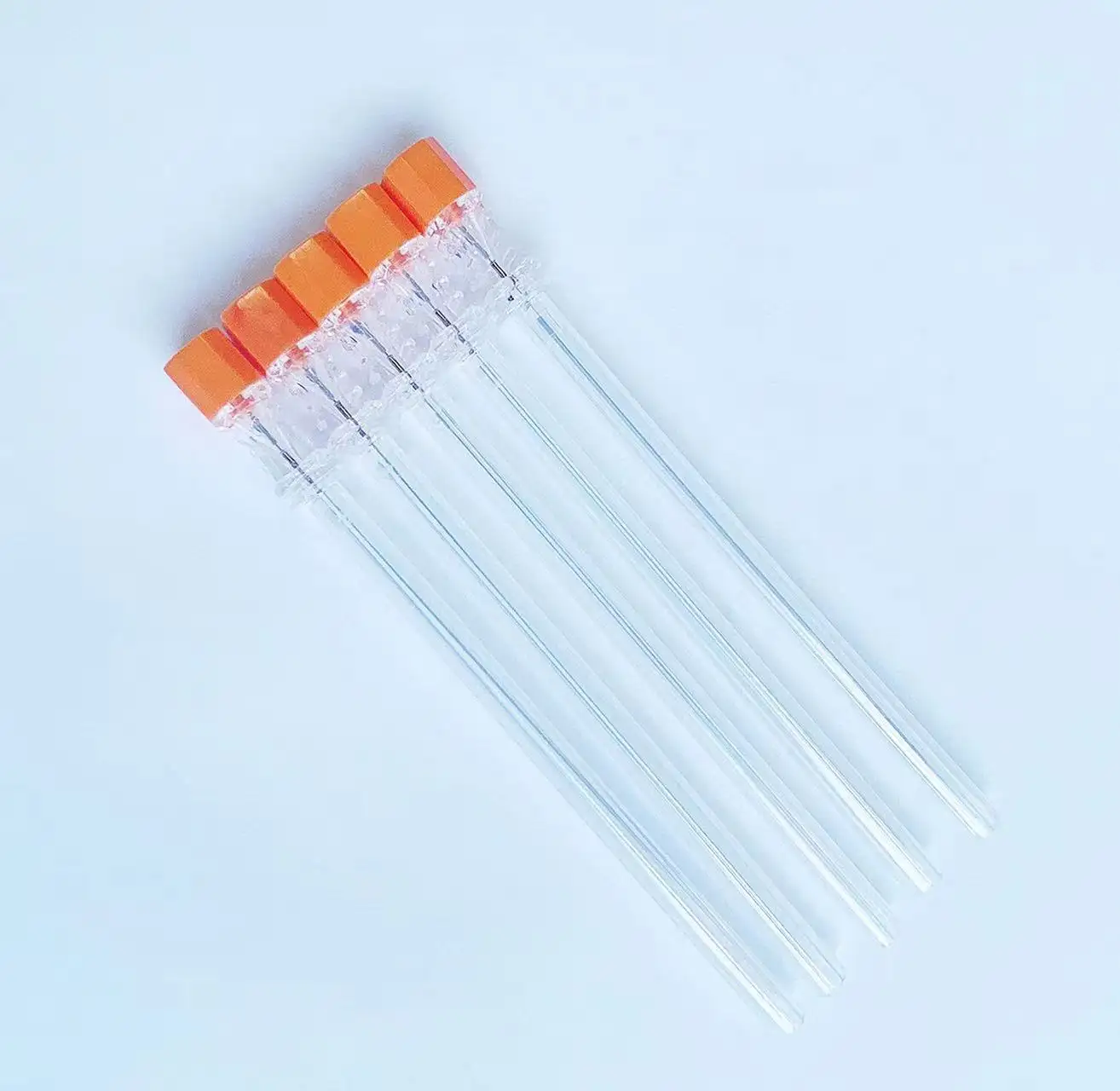Begrijp Invoegnaalden: Basis voor Beginners
Wat zijn Invoegnaalden?
Invoegnaalden fungeren als speciale hulpmiddelen die voornamelijk worden gebruikt om stoffen in lichaamsweefsels te brengen tijdens medische behandelingen. Artsen en therapeuten vertrouwen op deze apparaten bij talloze verschillende behandelingen, omdat ze medicijnen of andere stoffen precies daar kunnen toedienen waar ze nodig zijn, zonder de omliggende gebieden al te veel te beschadigen. De meeste van deze naalden hebben een buisvormig lichaam met een puntige uiteinde, waardoor het gemakkelijker is om indien nodig door de huidlagen heen te dringen. Nauwkeurigheid is erg belangrijk bij zaken als traditionele Chinese geneeskundepraktijken, het toedienen van medicijnen direct op probleemgebieden, en zelfs bepaalde schoonheidsbehandelingen. Aangezien er minder schade aan het weefsel zelf wordt toegebracht, herstellen patiënten over het algemeen sneller na de behandeling en hebben ze later minder last van problemen veroorzaakt door onjuiste inbrengtechnieken.
Belangrijkste onderdelen van een implantatienaald
Wat ervoor zorgt dat een inplantnaald goed werkt, komt neer op de belangrijkste onderdelen ervan. Allereerst is er de naaldschacht zelf. Dit onderdeel moet onder druk standhouden wanneer het in weefsel wordt gebracht. Als de naald tijdens de inbrenging buigt of breekt, gaat het snel fout. Vervolgens is er het ontwerp van de punt. De meeste punten zijn taps toelopend of hebben een schuine snede, zodat ze soepeler in glijden en minder ongemak veroorzaken. Sommige modellen zijn uitgerust met een extra functie die een duwmechanisme heet, vooral handig bij bepaalde medische behandelingen waarbij artsen de hoeveelheid af te geven materiaal tegelijkertijd moeten kunnen bepalen. Deze duwmechanismen laten medische professionals precies afmeten wat nodig is voor elke behandelingsronde, wat uiteraard erg belangrijk is om goede resultaten te behalen en patiënten veilig te houden. Iedereen die met deze naalden werkt, zou tijd moeten nemen om alles over deze verschillende onderdelen te leren voordat men daadwerkelijk procedures start.
Soorten Implantatienaalden en Hun Toepassingen
Veer- en herbruikbare naalden
Het grote verschil bij het gebruik van inbrengnaalden zit hem in de vraag of ze wegwerpbaar zijn of opnieuw gebruikt kunnen worden. Wegwerpnaalden worden na één gebruik weggegooid, wat het risico op besmetting en infecties aanzienlijk vermindert. Dat maakt ze erg geschikt voor gebruik in omgevingen waar het behouden van hygiëne het belangrijkst is, zoals ziekenhuizen of klinieken. Aan de andere kant zijn herbruikbare naalden beter voor het milieu, maar brengen ze wel eigen problemen met zich mee. Ze moeten tussen elke gebruik grondig worden gereinigd om veilig te blijven, iets wat tijd en geschikte apparatuur kost. Sommige zorgverleners kiezen er nog steeds voor wanneer ze afval willen verminderen of als ze al goede sterilisatievoorzieningen op staan. Uiteindelijk hangt de beste keuze vaak af van het soort procedure dat moet worden uitgevoerd en hoe gemakkelijk zorgverleners zich voelen bij het onderhouden van naaldhygiëne gedurende hun werkdag.
Gespecialiseerde naalden voor acupunctuur en medische procedures
Naalden die worden gebruikt voor het inbedden komen in verschillende soorten voor; sommige zijn speciaal gemaakt voor acupunctuur, terwijl andere bedoeld zijn voor diverse medische toepassingen. De naalden die in de acupunctuur worden gebruikt, hebben over het algemeen veel dunner puntige uiteinden. Deze fijne punten helpen om de pijn tijdens het invoeren te verminderen en maken de gehele ervaring beter voor patiënten die mogelijk nerveus zijn over het gebruik van naalden. Bij medische behandelingen zoals cosmetische fillers hebben de naalden vaak speciale eigenschappen die ervoor zorgen dat ze beter werken. Ze kunnen langer of korter zijn, afhankelijk van het lichaamsdeel dat behandeling nodig heeft, of verschillende diktes (bekend als maat) hebben, op basis van hoe diep de stof moet worden gebracht. Artsen en verpleegkundigen moeten goed op de hoogte zijn van al deze details van naalddesigns, zodat ze het juiste instrument voor elk specifiek doel kunnen kiezen. Het juiste keuze maken is erg belangrijk, omdat dit bepaalt of de behandeling goed werkt en veilig blijft voor iedereen die betrokken is.
Stapsgewijze handleiding voor het gebruik van een inslagingsnaald
De naald en werkplek voorbereiden
Voordat u een inbeddingsnaald gebruikt, moet u ervoor zorgen dat alles eerst goed gesteriliseerd is. De veiligheid van de patiënt gaat tenslotte voor alles, en niemand wil risico's op infecties door slechte voorbereiding. Begin met het grondig schoonmaken van de naald, bijvoorbeeld door hem door een autoclaaf te halen of in een oplossing van chemisch desinfectans te weken. Zorg vervolgens dat uw werkplek in orde is. Houd het netjes, mensen! Leg handschoenen klaar, desinfecterende doekjes en die handige kleine naaldhouders binnen handbereik, zodat u ze snel kunt pakken zonder te klungelen tijdens het eigenlijke proces. Gelooft u mij, niemand heeft tijd voor onderbrekingen bij delicate procedures. En vergeet niet de procedurehandleidingen goed door te lezen voordat u begint. Niet alleen snel even overlopen - neem elke stap serieus. Dit helpt om rustig te blijven en zorgt ervoor dat we alle richtlijnen van de regelgevende instanties volgen voor veilig en effectief gebruik van inbeddingsnaalden.
Invoertechnieken voor veilige toepassing
Goed worden in het correct plaatsen van naalden is erg belangrijk als we patiënten comfortabel willen houden en tegelijkertijd nauwkeurige resultaten willen behalen met ingebedde naalden. Allereerst moet de juiste invalshoek worden bepaald om onnodige pijn te voorkomen. De meeste professionals ontdekken dat ongeveer 45 graden in de meeste situaties goed werkt, waardoor de naald soepel op zijn plek glijdt zonder verzet van het weefsel. Diepteregeling is net zo belangrijk. Te weinig diepte betekent dat de behandeling niet op de juiste plek aankomt. Te veel diepte brengt het risico met zich mee om iets belangrijks onder het oppervlak te raken. Zodra de naald op de juiste plek zit, moet de toediening van het benodigde materiaal soepel en in een gelijkmatig ritme gebeuren. Oefening baart hier veel vrucht. Als het goed wordt uitgevoerd, leidt deze aanpak tot betere resultaten in het algemeen en voelen patiënten zich meer op hun gemak tijdens wat voor veel mensen een stressvolle procedure kan zijn.

Veiligheidsprotocollen en hygiëne beste praktijken
Sterilisatiemethoden voor inbrengnaalden
Het goed steriliseren van inbeddingsnaalden is erg belangrijk voor het in stand houden van veiligheid in medische omgevingen en therapeutisch werk. De meeste instellingen gebruiken autoclaveren, omdat dit de beste manier is om microben te doden met stoom onder druk bij hoge temperaturen. Als het proces goed wordt uitgevoerd, zorgt dit ervoor dat die kleine naalden tijdens procedures geen infecties zullen veroorzaken. Maar er is ook een andere aanpak voor instrumenten die mogelijk beschadigd kunnen worden door hitte. Daar komt chemische sterilisatie om de hoek kijken, waarbij verschillende desinfecteermiddelen worden gebruikt. Hoewel dit niet helemaal zo grondig is als sterilisatie met stoom, doen deze chemische behandelingen het nog steeds vrij goed tegen de meeste ziekteverwekkers, vooral bij gevoelige apparatuur. Ziekenhuizen en klinieken moeten regelmatig testen of hun sterilisatieprocessen daadwerkelijk werken. Zonder deze routinecontroles kunnen zelfs de beste protocollen op de lange termijn falen. Therapeuten zouden altijd moeten controleren of de gebruikte methode blijft voldoen aan de veiligheidseisen, zodat iedereen beschermd blijft tegen voorkombare infecties.
Veelvoorkomende Risico's en Complicaties Vermijden
Let op voor typische problemen bij het werken met inbeddingsnaalden is erg belangrijk voor het waarborgen van de patiëntveiligheid en het correct uitvoeren van procedures. Medewerkers hebben echt goede training nodig op het gebied van infectiepreventie en het correct hanteren van naalden. Voordat men iets invasiefs uitvoert, helpt het om regelmatig de apparatuur te controleren en eerst de situatie van elke patiënt te beoordelen, zodat mogelijke risico's vroegtijdig worden opgespoord. Wanneer artsen tijd nemen om te begrijpen wat elke persoon uniek maakt, kunnen zij hun aanpak aanpassen, wat leidt tot betere resultaten in het algemeen. Een aanpak die zich richt op wat individuele patiënten belangrijk vinden, zorgt er ook voor dat er minder negatieve reacties zijn. Gewoon tijd nemen om te luisteren naar hun zorgen en die kennis praktisch toe te passen tijdens de behandeling betekent vaak dat alles soepeler verloopt van begin tot eind.
Toepassingen van Implantatienaalden in de Moderne Geneeskunde
Therapeutische Toepassingen in Pijnbestrijding
Naalden die worden gebruikt voor het inbedden zijn erg belangrijk geworden in het verbeteren van pijnbeheer en het bieden van gerichte behandelingen precies waar mensen het meest pijn hebben. Droge naaldtherapie is één techniek die werkt door die strakke spierknopen aan te pakken en de spanning te verminderen, wat erg goed helpt bij chronische pijnproblemen. Onderzoeken bevestigen dit ook en tonen aan dat mensen minder pijn ervaren na deze behandelingen, ongeacht leeftijd of aandoening. Hoewel er niet over alles overeenstemming is over naaldtherapie, is er geen twijfel over dat artsen en therapeuten steeds vaker deze methoden gebruiken wanneer traditionele benaderingen tekortschieten. Ze zijn tegenwoordig zeker een veelgebruikte optie geworden in veel klinieken voor diverse soorten pijnproblemen.
Cosmetische en dermatologische procedures
Cosmetische behandelingen maken vaak gebruik van inbeddingsnaalden voor onder andere dermale fillers en micro-needling, omdat het goed positioneren van groot belang is om goede huidverjongingsresultaten te behalen. Deze naalden stellen artsen in staat materialen precies daar te brengen waar ze nodig zijn, wat helpt bij het behalen van betere resultaten in het algemeen en de huidtoestand te verbeteren. Wij hebben de laatste tijd een toename gezien van mensen die voor dit soort procedures kiezen, waardoor fabrikanten speciale inbeddingsnaalddesigns specifiek voor cosmetisch gebruik zijn gaan ontwikkelen. Zij reageren op wat patiënten momenteel wensen, namelijk een betere textuur en uiterlijk na de behandeling. Met deze groeiende interesse lijken inbeddingsnaalden een steeds belangrijkere rol te spelen in de cosmetische dermatologie. Veel klinieken passen hun aanpak van huidverzorging en verjonging al aan dankzij deze vooruitgang in naaldtechnologie.
Problemen oplossen voor beginners
Omgaan met naaldgevoeligheid of ongemak
Iedereen reageert anders als het gaat om het inbrengen van naalden. Sommige mensen voelen bijna niets, terwijl anderen het vrij onaangenaam kunnen vinden. Beginnende acupuncturisten moeten letten op deze variatie en hun methode aanpassen, zodat patiënten niet het hele procedé door moeten worstelen met pijn. Het is verstandig om patiënten van tevoren even te spreken. Zo kan de acupuncturist inschatten hoe gevoelig iemand mogelijk is en kan de behandeling daarop worden afgestemd. Voor mensen die erg nerveus of gevoelig zijn, helpt het gebruik van een verdovende crème wonderen. Het meenemen van deze individuele verschillen zorgt niet alleen voor een betere ervaring voor alle betrokkenen, maar vergroot ook de kans dat de behandeling werkelijk werkt zoals de bedoeling is.
Technieken aanpassen aan verschillende huidtypes
Huid verschilt zo veel dat verschillende naaldbenaderingen beter werken voor verschillende mensen. Het begrijpen van wat elke huidtype bijzonder maakt, is belangrijk om goede resultaten te behalen. Neem bijvoorbeeld gevoelige huid. Mensen met dit type huid hebben vaak zachtere injectietechnieken nodig om roodheid of andere problemen te voorkomen. Ook de naaldgrootte speelt een rol. Het kiezen van de juiste maat verandert echt het behaalde resultaat, en deze keuze hangt af van factoren zoals huidverdikking en elasticiteit. Huidtherapeuten moeten blijven leren en hun methoden aanpassen naarmate ze verschillende huidcondities tegenkomen. Het geheel draait om het voortdurend aanpassen aan individuele behoeften. Wanneer technici flexibel blijven in hun aanpak, voelen patiënten zich over het algemeen prettiger bij de behandeling, omdat deze dan persoonlijker overkomt.
FAQ
Waar worden naaldbedrijven voor gebruikt?
Naaldbedrijven worden gebruikt voor het injecteren van materialen in weefsels bij medische en therapeutische procedures zoals acupunctuur, medicijnafgifte en cosmetische behandelingen.
Hoe minimaliseren naaldbedrijven weefselbeschadiging?
Het ontwerp van inplantnaalden omvat een holle schacht en een scherpe punt, waardoor stoffen nauwkeurig kunnen worden toegediend met minimale weefselbeschadiging.
Wat is het verschil tussen wegwerpinplantnaalden en herbruikbare inplantnaalden?
Wegwerpinplantnaalden zijn voor eenmalig gebruik bedoeld, wat het risico op infecties vermindert, terwijl herbruikbare naalden grondige sterilisatie vereisen en vaak worden gebruikt om medisch afval te verminderen.
Hoe belangrijk is sterilisatie voor inplantnaalden?
Sterilisatie is cruciaal om microbieel leven te elimineren en ervoor te zorgen dat de naalden veilig zijn voor gebruik bij medische procedures, waarmee infecties en complicaties worden voorkomen.
Hoe worden inplantnaalden gebruikt in pijnpoli?
Bij pijnpoli worden inplantnaalden gebruikt in technieken zoals droge naaldtherapie om spierknots te behandelen en spanning te verminderen, waardoor langdurige pijnverlichting wordt geboden.
Inhoudsopgave
- Begrijp Invoegnaalden: Basis voor Beginners
- Soorten Implantatienaalden en Hun Toepassingen
- Stapsgewijze handleiding voor het gebruik van een inslagingsnaald
- Veiligheidsprotocollen en hygiëne beste praktijken
- Toepassingen van Implantatienaalden in de Moderne Geneeskunde
- Problemen oplossen voor beginners
- FAQ

